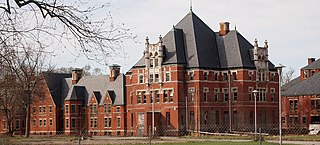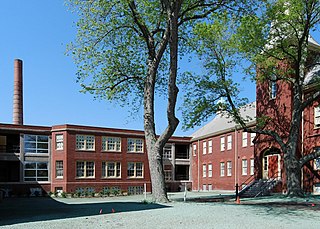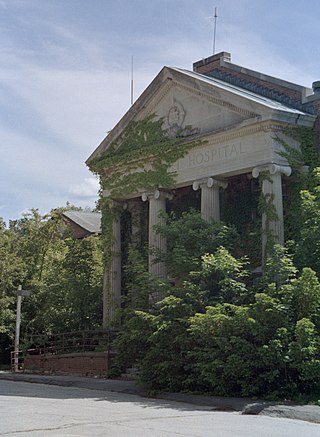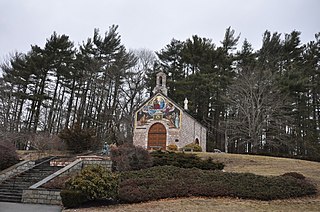
The Walter E. Fernald State School, later the Walter E. Fernald Developmental Center, was the Western hemisphere's oldest publicly funded institution serving people with developmental disabilities. Originally a Victorian sanatorium, it became a "poster child" for the American eugenics movement during the 1920s. It later was the scene of medical experiments in the 20th century. Investigations into this research led to new regulations regarding human research in children.

The Danvers State Hospital, also known as the State Lunatic Hospital at Danvers, The Danvers Lunatic Asylum, and The Danvers State Insane Asylum, was a psychiatric hospital located in Danvers, Massachusetts. It was built in 1874, and opened in 1878, under the supervision of prominent Boston architect Nathaniel Jeremiah Bradlee, on an isolated site in rural Massachusetts. It was a multi-acre, self-contained psychiatric hospital designed and built according to the Kirkbride Plan.

Taunton State Hospital is a psychiatric hospital located on Hodges Avenue in Taunton, Massachusetts. Established in 1854, it was originally known as the State Lunatic Hospital at Taunton. It was the second state asylum in Massachusetts. Most of the original part of the facility was built in a unique and rare neo-classical style designed by architects Boyden & Ball. It is also a Kirkbride Plan hospital and is located on a large 154-acre (62 ha) farm along the Mill River.

Agnews Developmental Center was a psychiatric and medical care facility, located in Santa Clara, California.

Harrisburg State Hospital, formerly known from 1851 to 1937 as Pennsylvania State Lunatic Hospital, in Harrisburg, Pennsylvania, was Pennsylvania's first public facility to house the mentally ill and disabled. Its campus is located on Cameron and Maclay Streets, and operated as a mental hospital until 2006.

The Institute of Pennsylvania Hospital, also known as Kirkbride's Hospital or the Pennsylvania Hospital for Mental and Nervous Diseases, was a psychiatric hospital located at 48th and Haverford Streets in Philadelphia, Pennsylvania, USA. It operated from its founding in 1841 until 1997. The remaining building, now called the Kirkbride Center is now part of the Blackwell Human Services Campus.

Dixmont State Hospital was a hospital located northwest of Pittsburgh, Pennsylvania. Built in 1862, Dixmont was once a state-of-the-art institution known for its highly self-sufficient and park-like campus, but a decline in funding for state hospitals and changing philosophies in psychiatric care caused the hospital to be closed in 1984. After more than two decades of abandonment, it was demolished in 2006. The campus spanned a total of 407 acres (165 ha). Reed Hall is listed on the National Register of Historic Places.

The Norwich State Hospital, originally established as Norwich State Hospital for the Insane and later shortened to Norwich Hospital, is a former psychiatric hospital that is located in Preston and Norwich, Connecticut. It opened its doors in October 1904 and operated until October 10, 1996. Throughout its years of operation, it housed geriatric patients, chemically dependent patients and, from 1931 to 1939, tubercular patients. The hospital, which sits on the banks of the Thames River, began with a single building on 100 acres (40 ha) of land and expanded to, at its peak, over thirty buildings and 900 acres (360 ha).

Grafton State Hospital was a psychiatric hospital in Grafton, Massachusetts that operated from 1901 to 1973. Today, the site has been redeveloped with Tufts University's Cummings School of Veterinary Medicine as a major occupant, along with the Grafton Job Corps office and various other State agencies.

Westborough State Hospital, originally "Westborough Insane Hospital", was a historic hospital in Westborough, Massachusetts, which sat on more than 600 acres (240 ha). The core campus area was located between Lyman Street and Chauncy Lake, north of Massachusetts Route 9. The hospital was added to the National Register of Historic Places in 1994.

Foxborough State Hospital, historically known as the Massachusetts Hospital for Dipsomaniacs and Inebriates, is a historic medical treatment facility at the junction of Chestnut and Main Streets in Foxborough, Massachusetts. The creation of an alcohol abuse treatment facility was authorized by state legislation in 1889, and the Foxborough campus was developed in the 1890s. The original campus consisted of a series of residential wards in an L shape, with an administration building at the center, and a variety of ancillary support buildings on the grounds. Problems with the facility, including its location, prompted the state to move the substance abuse facility in 1914 to a new campus in Norfolk. The Foxborough campus was then adapted for use as a standard mental hospital. The surviving 19th-century elements of the campus were listed on the National Register of Historic Places in 1994.

The Monson Developmental Center was a Massachusetts state facility in Monson, Massachusetts. The property, whose core has been in state control since 1854, historically housed a variety of facilities for providing services to the indigent or sick. It was closed in 2012, and the state is soliciting bids for sale and reuse of the developed portions of the property.

The Mansfield Training School and Hospital was a state school for people with developmental disabilities located in Mansfield, Connecticut, United States. It was active from 1860 to 1993. Its former campus, located at the junction of Connecticut Route 32 and United States Route 44 in Mansfield is a 350-acre (140 ha) historic district that was listed on the National Register of Historic Places in 1987.

The Front Street Historic District in Exeter, New Hampshire, encompasses a portion of the town's historic center. The district extends from Swasey Pavilion, at the junction of Front and Water streets, southwesterly along Front Street to Gale Park, about five blocks. Front Street is one of Exeter's oldest roads, and is lined with a series of 18th and 19th-century civic, religious, and residential structures, many of which are well preserved. The district was listed on the National Register of Historic Places (NRHP) in 1973.

Vermont State Hospital, alternately known as the Vermont State Asylum for the Insane and the Waterbury Asylum, was a mental institution built in 1890 in Waterbury, Vermont to help relieve overcrowding at the privately run Vermont Asylum for the Insane in Brattleboro, Vermont, now known as the Brattleboro Retreat. Originally intended to treat the criminally insane, the hospital eventually took in patients with a wide variety of problems, including mild to severe mental disabilities, epilepsy, depression, alcoholism and senility. The hospital campus, much of which now houses other state offices as the Waterbury State Office Complex, was listed on the National Register of Historic Places in 2016. Partly as a replacement for this facility, the state currently operates the 25 bed Vermont Psychiatric Care Hospital in Berlin, Vermont.

The Templeton Developmental Center was a state-run facility for mentally disabled people located in Templeton, in the U.S. state of Massachusetts. Founded as the Templeton Farm Colony in 1899 through the efforts of Walter E. Fernald, superintendent of what is now called the Fernald School in Waltham, Massachusetts, it was considered an innovative and progressive facility for managing the state's developmentally disabled population at the time. The large facility was closed in 2015, with some intermediate care facilities remaining open on the campus. The property and some of the buildings were listed on the National Register of Historic Places in 1994.

The Northampton Veterans Affairs Medical Center, formerly the Northampton Veterans Administration Hospital, is a facility of the United States Department of Veterans Affairs (VA) at 421 Main Street in the Leeds section of northern Northampton, Massachusetts. Its campus once consisted of about 286 acres (116 ha) of land, which had by 2012 been reduced to 105 acres (42 ha). The hospital was opened in 1924 to treat neuropsychiatric patients, but now provides a wider array of medical services.

The Brandon State School, also known historically as the Brandon Training School and the Vermont State School for Feeble Minded Children, was a psychiatric facility for the care and treatment of children in Brandon, Vermont. Founded in 1915, it was Vermont's first state-funded residential facility for the care of the mentally handicapped. It was closed in 1993, a consequence of changing policies in the treatment and care of such individuals. The surviving buildings of the property, now converted to other uses, were listed on the National Register of Historic Places in 1999.

The Maine Insane Hospital, later the Augusta Mental Health Institute (AMHI), was a psychiatric hospital in Augusta, Maine. It was the principal facility for the care and treatment of Maine's mentally ill from 1840 to 2004, and its surviving buildings represent the oldest surviving complex of mental care facilities in the United States. The complex is located on the east bank of the Kennebec River, immediately south of the former Kennebec Arsenal, and now primarily houses state offices. In 2004, the hospital was replaced by the Riverview Psychiatric Center, located just to the south. The hospital's core complex was listed on the National Register of Historic Places in 1982, with the listing enlarged to encompass the entire campus in 2001.

The Cardinal Cushing Centers are a set of education and support facilities for developmentally and intellectually challenged adults and children operated by the Sisters of St. Francis of Assisi. The centers offer education, training, residential and employment services, and recreational facilities on a campus at 369 Washington Street in Hanover, Massachusetts. Opened in 1949 as St. Coletta's by the Sea through the efforts of Archbishop Richard Cushing and with funding from the Kennedy family, the center was one of the first of its kind in the nation, and was renamed in Cushing's honor in 1974. The campus was listed on the National Register of Historic Places in 2018.























